Assessing Catchment Resilience Using Entropy Associated with Mean Annual Runoff for the Upper Vaal Catchment in South Africa
Abstract
:1. Introduction
2. Entropy, Resilience, Pseudo-Elasticity and Mean Annual Runoff
2.1. Entropy and Mean Annual Runoff
2.2. Entropy and Resilience of Water Resources
2.3. Elasticity and Mean Annual Runoff
3. Data Availability and Methods
3.1. Study Area and Data Availability
3.2. Methods
3.2.1. Marginal Entropy Computation
3.2.2. Linear Resilience Zoning Determination
3.2.3. Determination of MAR Pseudo-Elasticity of Entropy
- -
- The robust standard error of the sample of the mean of elasticity values (the standard deviation of the sampling distribution) was computed.
- -
- The 95% class interval was used for the mean elasticity (e.g., limits of critical values times the standard error to/from the mean were computed, using a t-test. This was to assess the significance of the difference in mean of sampling distribution). Hence, the significance level of variability of MAR elasticity estimates is 0.05.
- -
- The assessment of goodness-fit of regression models was carried out using the coefficient of determination R2 (correlation coefficient R). Generally, R2 between 0.5 and 1 can be considered good for the linear regression. However, the statistical t-test was used to carry out the significance of R. The level of significance used was 0.05.
4. Results and Discussion
4.1. Entropy for Linear Resilience Zoning
4.2. MAR Pseudo-Elasticity of Entropy
5. Conclusions
Acknowledgments
Conflicts of Interest
References
- Liu, D.; Wang, D.; Wang, Y.; Wu, J.; Singh, V.P.; Zeng, X.; Wang, L.; Chen, Y.; Chen, X.; Zhang, L.; et al. Entropy of hydrological systems under small samples: Uncertainty and variability. J. Hydrol. 2016, 532, 163–176. [Google Scholar] [CrossRef]
- Singh, V.P. Hydrologic synthesis using entropy theory: Review. J. Hydrol. Eng. 2011, 16, 421–433. [Google Scholar] [CrossRef]
- Shannon, C.E.; Weaver, W. The Mathematical Theory of Communication; University of Illinois Press Urbana: Chicago, IL, USA; London, UK, 1949. [Google Scholar]
- Harmancioglu, N.B.; Yevjevich, V. Transfer of hydrologic information among rivers points. J. Hydrol. 1987, 93, 103–118. [Google Scholar] [CrossRef]
- Yang, Y.; Burn, H. Entropy approach to data collection network design. J. Hydrol. 1994, 94, 307–324. [Google Scholar] [CrossRef]
- Pan, F.; Pachepsky, Y.A.; Guber, A.K.; McPherson, B.J.; Hill, R.L. Scale effects on information theory-based measures applied to streamflow in two rural watersheds. J. Hydrol. 2012, 414–415, 99–107. [Google Scholar] [CrossRef]
- Cabral, P.; Augusto, G.; Tewolde, M.; Araya, Y. Entropy in Urban Systems. Entropy 2013, 15, 5223–5236. [Google Scholar] [CrossRef]
- Comfort, L.K.; Oh, N.; Ertan, G. The Dynamics of Disaster Recovery: Resilience and Entropy in Hurricane Response Systems 2005–2008. Public Org. Rev. 2009, 9, 309–323. [Google Scholar] [CrossRef]
- Mayer, A.L.; Donovan, R.P.; Pawlowski, C.W. Information and entropy theory for the sustainability of coupled human and natural systems. Ecol. Soc. 2014, 19, 11. [Google Scholar] [CrossRef]
- Ehret, U.; Gupta, H.V.; Sivapalan, M.; Weijs, S.V.; Schymanski, S.J.; Blöschl, G.; Gelfan, A.N.; Harman, C.; Kleidon, A.; Bogaard, T.A.; et al. Advancing catchment hydrology to deal with predictions under change. Hydrol. Earth Syst. Sci. 2014, 18, 649–671. [Google Scholar] [CrossRef]
- Greco, R.; Dinardo, A.; Santonastaso, G. Resilience and entropy as indices of robustness of water distribution networks. J. Hydroinform. 2012, 14, 761–771. [Google Scholar] [CrossRef]
- Creaco, E.; Fortunato, A.; Franchinia, M.; Mazzola, M.R. Comparison between entropy and resilience as indirect measures of reliability in the framework of water distribution network design. Procedia Eng. 2014, 70, 379–388. [Google Scholar] [CrossRef]
- Carey, S.K.; Tetzlaff, D.; Seibert, J.; Soulsby, C.; Buttle, J.; Laudon, H.; McDonnell, J.; McGuire, K.; Caissie, D.; Shanley, J.; et al. Inter-comparison of hydro-climatic regimes across Northern catchments: Synchronicity, resistance and resilience. Hydrol. Process. 2010. [Google Scholar] [CrossRef]
- Vogel, R.M.; Bolognese, R.A. Storage-reliability-resilience-yield relations for over-year water supply systems. Water Resour. Res. 1995, 31, 645–654. [Google Scholar] [CrossRef]
- Asefa, T.; Clayton, J.; Adams, A.; Anderson, D. Performance evaluation of a water resources system under varying climatic conditions: Reliability, Resilience, Vulnerability and beyond. J. Hydrol. 2014, 508, 53–65. [Google Scholar] [CrossRef]
- Gallopin, G.C. Linkages between vulnerability, resilience, and adaptive capacity. Glob. Environ. Chang. 2006, 16, 293–303. [Google Scholar] [CrossRef]
- Kjeldsen, T.R.; Rosbjerg, D. Choice of reliability, resilience and vulnerability estimators for risk assessments of water resources systems. Hydrol. Sci. J. Sci. Hydrol. 2004, 49, 755–767. [Google Scholar]
- Béné, C.; Newsham, C.; Davies, M.; Ulrichs, M.; Godfrey-Wood, R. Review article: Resilience, Poverty and Development. J. Int. Dev. 2014, 26, 598–623. [Google Scholar] [CrossRef]
- Müller, F.; Bergmann, M.; Dannowski, R.; Dippner, J.W.; Gnauck, A.; Haase, P.; Jochimsen, M.C.; Kasprzak, P.; Krönckei, I.; Kümmerlin, R.; et al. Assessing resilience in long-term ecological data sets. Ecol. Indic. 2016, 65, 10–43. [Google Scholar] [CrossRef]
- Peterson, T.J.; Western, A.W. Multiple hydrological attractors under stochastic daily forcing: 1. Can multiple attractors exist? Water Resour. Res. 2014, 50, 2993–3009. [Google Scholar] [CrossRef]
- Peterson, T.J.; Western, A.W.; Argent, R.M. Multiple hydrological attractors under stochastic daily forcing: 2. Can multiple attractors emerge? Water Resour. Res. 2014, 50, 3010–3029. [Google Scholar] [CrossRef]
- Anderies, J.M. Minimal models and agroecological policy at the regional scale: An application to salinity problems in southeastern Australia. Reg. Environ. Chang. 2005, 5, 1–17. [Google Scholar] [CrossRef]
- Tamea, S.; Laio, F.; Ridolfi, L.; D’Odorico, P.; Rodriguez-Iturbe, I. Ecohydrology of groundwater-dependent ecosystems: 2. Stochastic soil moisture dynamics. Water Resour. Res. 2009, 45, W05420. [Google Scholar] [CrossRef]
- Desouza, K.C.; Flanery, T.H. Designing, planning, and managing resilient cities: A Conceptual Framework. Cities 2013, 35, 89–99. [Google Scholar] [CrossRef]
- Fistola, R.; La Rocca, R.A. The Sustainable City and the Smart City: Measuring urban entropy first. WIT Trans. Ecol. Environ. 2014, 191, 537–548. [Google Scholar]
- Liquan, X.; Junqing, Z. The New Town Development in Ecological Sensitive Area Based on Resilience Thinking. Procedia Soc. Behav. Sci. 2016, 216, 998–1005. [Google Scholar] [CrossRef]
- Anderies, J.M.; Janssen, M.A.; Walker, B.H. Grazing management, resilience, and the dynamics of a fire-driven rangeland system. Ecosystems 2002, 5, 23–44. [Google Scholar] [CrossRef]
- Walker, B.; Meyers, J.A. Thresholds in ecological and social–ecological systems: A developing database. Ecol. Soc. 2004, 9, 3. [Google Scholar] [CrossRef]
- Forbes, B.C.; Stammler, F.; Kumpula, T.; Meschtyb, N.; Pajunen, A.; Kaarlejarvi, E. High Resilience in the Yamal-Nenets Social–Ecological System, West Siberian Arctic, Russia. Proc. Natl. Acad. Sci. USA 2009, 106, 22041–22048. [Google Scholar] [CrossRef] [PubMed]
- Cavallaro, M.; Asprone, D.; Latora, V.; Manfredi, G.; Nicosia, V. Assessment of Urban Ecosystem Resilience through Hybrid Social–Physical Complex Networks. Comput. Aided Civ. Infrastruct. Eng. 2014, 29, 608–625. [Google Scholar] [CrossRef]
- Wang, C.-H.; Blackmore, J.; Wang, X.; Yum, K.-K.; Zhou, M.; Diaper, C.; McGregor, G.; Anticev, J. Overview of Resilience Concepts, with Application to Water Resource Systems. eWater Technical Report, Canberra. 2009. Available online: http://ewatercrc.com.au/reports/ResilienceConcepts.pdf (accessed on 12 November 2014).
- Fowler, H.J.; Kilsby, C.G.; O’Connell, P.E. Modeling the impacts of climatic change and variability on the reliability, resilience, and vulnerability of a water resource system. Water Resour. Res. 2003, 39. [Google Scholar] [CrossRef]
- D’Odorico, P.; Bhattachan, A. Hydrologic variability in dryland regions: Impacts on ecosystem dynamics and food security. Philos. Trans. R. Soc. Lond. B Biol. Sci. 2012, 367, 3145–3157. [Google Scholar] [CrossRef] [PubMed]
- Borgogno, F.; D’Odorico, P.; Laio, F.; Ridolfi, L. Effect of rainfall interannual variability on the stability and resilience of dryland plant ecosystems. Water Resour. Res. 2007, 43, W06411. [Google Scholar] [CrossRef]
- Singh, V.P.; Fiorentino, M. A Historical Perspective of Entropy Applications in Water Resources; Kluwer Academic Publishers: Dodrecht, The Netherlands, 1992; pp. 21–61. [Google Scholar]
- Singh, V.P. The use of entropy in hydrology and water resources. Hydrol. Process. 1997, 11, 587–626. [Google Scholar] [CrossRef]
- Castillo, A.; Castelli, F.; Entekhabi, D. An entropy-based measure of hydrologic complexity and its applications. Water Resour. Res. 2014, 5145–5160. [Google Scholar] [CrossRef] [PubMed]
- Teutschbein, C.; Grabs, T.; Karlsen, R.H.; Laudon, H.; Bishop, K. Hydrological response to changing climate conditions: Spatial streamflow variability in the boreal region. Water Resour. Res. 2015, 1–22. [Google Scholar] [CrossRef]
- Singh, V.P. Entropy as a decision tool in environmental and water resources. Indian Assoc. Hydrol. Hydrol. J. 1998, 21, 1–12. [Google Scholar]
- Marini, G.; Zollo, R.; Fontanaa, N.; Giugni, M.; Singh, V.P. Variability and trends in streamflow in northeast United States, The Fourth Italian Workshop on Landslides. Procedia Earth Planet. Sci. 2016, 16, 156–165. [Google Scholar] [CrossRef]
- Halverson, M.J.; Fleming, S.W. Complex network theory, streamflow, and hydrometric monitoring system design. Hydrol. Earth Syst. Sci. 2015, 19, 3301–3318. [Google Scholar] [CrossRef]
- Meerow, S.; Newell, J.P.; Stults, M. Defining urban resilience: A review. Landsc. Urban Plan. 2016, 147, 38–49. [Google Scholar] [CrossRef]
- Middleton, B.J.; Bailey, A.K. Water Resources of South Africa, 2005 Study (WR2005), version 2; User’s Guide, Water Research Commission Report No TT 513/11; Water Research Commission: Pretoria, South Africa, 2011. [Google Scholar]
- Midgley, D.C.; Pitman, W.V.; Middleton, B.J. Surface Water Resources of South Africa 1990; WRC Report No. 298/1.1/94 to 298/6.2/94; Water Research Commission: Pretoria, South Africa, 1994; Volume I–IV. [Google Scholar]
- Shi, P.J.; Yuan, Y.; Zheng, J.; Wang, J.A.; GE, Y.; Qiu, G.Y. The effect of land use/cover change on surface runoff in Shenzhen, China. Catena 2007, 69, 31–35. [Google Scholar] [CrossRef]
- Ilunga, M.; Onyari, E.K. Measuring variability of mean annual runoff for the Upper Vaal catchment using entropy. In Proceedings of the 35th IASTED International Conference, Modelling, Identification and Control (MIC 2016), Innsbruck, Austria, 15–16 February 2016; pp. 221–226. [Google Scholar]
- Andréassian, V.; Coron, L.; Lerat, J.; Le Moine, N. Climate elasticity of streamflow revisited—An elasticity index based on long-term hydrometeorological records. Hydrol. Earth Syst. Sci. 2016, 20, 4503–4524. [Google Scholar] [CrossRef]
- Bassiouni, M.; Vogel, R.M.; Archfield, S.A. Panel regressions to estimate low-flow response to rainfall variability in ungaged basins. Water Resour. Res. 2016, 1–25. [Google Scholar] [CrossRef]
- Meng, F.; Su, F.; Yang, D.; Tong, K.; Hao, Z. Impacts of recent climate change on the hydrology in thesource region of the Yellow River basin. J. Hydrol. Reg. Stud. 2016, 6, 66–81. [Google Scholar] [CrossRef]
- Allaire, M.C.; Vogel, M.R.; Kroll, C.N. The hydro-morphology of an urbanizing watershed using multivariate elasticity. Adv. Water Resour. 2015, 86, 147–154. [Google Scholar] [CrossRef]
- Li, E.; Mu, X.; Zhao, G.; Gao, P.; Shao, H. Variation of Runoff and Precipitation in the Hekou-Longmen Region of the Yellow River Based on Elasticity Analysis. Sci. World J. 2014, 2014, 929858. [Google Scholar] [CrossRef] [PubMed]
- Sankarasubramaniam, A.; Vogel, R.M.; Limburner, J.F. Climate elasticity of streamflow in the United States. Water Resour. Res. 2001, 37, 1771–1781. [Google Scholar] [CrossRef]
- Fu, G.; Charles, S.P.; Chiew, F.H.S. A two-parameter climate elasticity of streamflow index to assess climate change effects on annual streamflow. Water Resour. Res. 2007, 43, W11419. [Google Scholar] [CrossRef]
- Potter, N.J.; Petheram, C.; Zhang, L. Sensitivity of streamflow to rainfall and temperature in south-eastern Australia during the Millennium drought. In Proceedings of the 19th International Congress on Modelling and Simulation, Perth, Australia, 12–16 December 2011; Available online: http://mssanz.org.au/modsim2011 (accessed on 17 February 2016).
- Konapala, G.; Ashok, K.; Mishra, A.K. Three-parameter-based streamflow elasticity model: Application to MOPEX basins in the USA at annual and seasonal scales. Hydrol. Earth Syst. Sci. 2016, 20, 2545–2556. [Google Scholar] [CrossRef]
- Chiew, H.S.F. Estimation of rainfall elasticity of streamflow in Australia. Hydrol. Sci. J. 2006, 51, 613–625. [Google Scholar] [CrossRef]
- Chiew, F.H.S.; Peel, M.C.; McMahon, T.A.; Siriwardena, L.W. Precipitation elasticity of streamflow in catchments across the world. In Climate Variability and Change—Hydrological Impacts, Proceedings of the Fifth FRIEND World Conference, Havana, Cuba, 27 November–1 December 2006; IAHS Publ. 2006; 308, pp. 256–262. [Google Scholar]
- Department of Water Affairs. Upper Vaal Management Area: Overview of Water Resources Availability and Utilisation; Report No. PWA 08/000/00/0203; Department of Water Affairs: Pretoria, South Africa, 2003.
- Ilunga, M.; Singh, V.P. Measuring spatial variability of land use associated with hydrological impact in urbanized quaternary catchment using entropy. Water SA 2015, 41, 41–54. [Google Scholar] [CrossRef]
- McMahon, T.A.; PeeL, M.C.; Pegram, G.G.S.; Smith, I.N. A Simple Methodology for Estimating Mean and Variability of Annual Runoff and Reservoir Yield under Present and Future Climates. J. Hydrometeorol. 2011, 11, 135–146. [Google Scholar] [CrossRef]
- Amorocho, J.; Espildora, B. Entropy in the assessment of uncertainty in hydrologic systems and models. Water Resour. Res. 1973, 9, 1511–1522. [Google Scholar] [CrossRef]
- Jowitt, P.M. The Extreme Value Type-1 distribution and the principle of maximum entropy. J. Hydrol. 1979, 42, 23–38. [Google Scholar] [CrossRef]
- Sonuga, J.O. Principle of maximum entropy in hydrologic frequency analysis. J. Hydrol. 1972, 30, 81–94. [Google Scholar] [CrossRef]
- Krstanovic, P.F.; Singh, V.P. A Univariate model for long-term streamflow forecasting. Stoch. Hydrol. Hydraul. 1991, 5, 173–188. [Google Scholar] [CrossRef]
- Yang, Z.F.; Yan, Y.; Liu, Q. The relationship of Streamflow-Precipitation-Temperature in the Yellow River Basin of China during 1961–2000. Procedia Environ. Sci. 2012, 13, 2336–2345. [Google Scholar] [CrossRef]
- Jain, S.K.; Bhunya, P.K. Reliability, resilience and vulnerability of a multipurpose storage reservoir. Hydrol. Sci. J. Sci. Hydrol. 2008, 53, 434–447. [Google Scholar] [CrossRef]
- Runyan, C.W.; D’Odorico, P. Ecohydrological feedbacks between salt accumulation and vegetation dynamics: Role of vegetation-groundwater interactions. Water Resour. Res. 2010, 46, W11561. [Google Scholar] [CrossRef]
- Ajami, N.K.; Hornberger, G.M.; Sunding, D.L. Sustainable water resource management under hydrological Uncertainty. Water Resour. Res. 2008, 44, W11406. [Google Scholar] [CrossRef]
- Huang, F.; Chunyu, X.; Wang, Y.; Wu, Y.; Qian, B.; Guo, L.; Zhao, D.; Xia, Z. Investigation into Multi-Temporal Scale Complexity of Streamflows and Water Levels in the Poyang Lake Basin, China. Entropy 2017, 19, 67. [Google Scholar] [CrossRef]
- Thompson, I. Biodiversity, ecosystem thresholds, resilience and forest degradation. Unasylva 2012, 238, 25–30. [Google Scholar]
- Willis, K.J.; Bailey, R.M.; Bhagwat, S.A.; Birks, H.J.B. Biodiversity baselines, thresholds and resilience: Testing predictions and assumptions using palaeoecological data. Trends Ecol. Evolut. 2010, 25, 583–591. [Google Scholar] [CrossRef] [PubMed]
- Vano, J.A.; Das, T.; Lettenmaier, D.P. Hydrologic Sensitivities of Colorado River Runoff to Changes in Precipitation and Temperature. J. Hydrometeorol. 2012, 13, 932–949. [Google Scholar] [CrossRef]
- National Water Resource Strategy. Department of Water Affairs (Pretoria: DWA): South Africa, 2013. Available online: https://www.dwa.gov.za/nwrs/NWRS2013.aspx (accessed on 29 September 2016).
- Zhou, X.; Zhang, Y.; Yang, Y. Comparison of Two Approaches for Estimating Precipitation Elasticity of Streamflow in China’s Main River Basins. Adv. Meteorol. 2015, 2015, 924572. [Google Scholar] [CrossRef]
- Water Resources of South Africa. 2012 Study (WR2012). Available online: http://waterresourceswr2012.co.za/ (accessed on 29 September 2016).
- Wrzesinski, D. Use of Entropy in the Assessment of Uncertainty of River Runoff Regime in Poland. Acta Geophys. 2016, 64, 1825–1839. [Google Scholar] [CrossRef]
- McKenzie, R.S.; Allen, R.B. Modern water resource assessment techniques for the Vaal system. Proc. Inst. Civ. Eng. 1990, 88, 995–1014. [Google Scholar] [CrossRef]
- Mukheibir, P. Water resources management strategies for adaptation to climate-induced impacts in South Africa. Water Resour. Manag. 2008, 22, 1259–1276. [Google Scholar] [CrossRef]
- Friend, R.; Moench, M. What is the purpose of urban climate resilience? Implications for addressing poverty and Vulnerability. Urban Clim. 2013, 6, 98–113. [Google Scholar] [CrossRef]
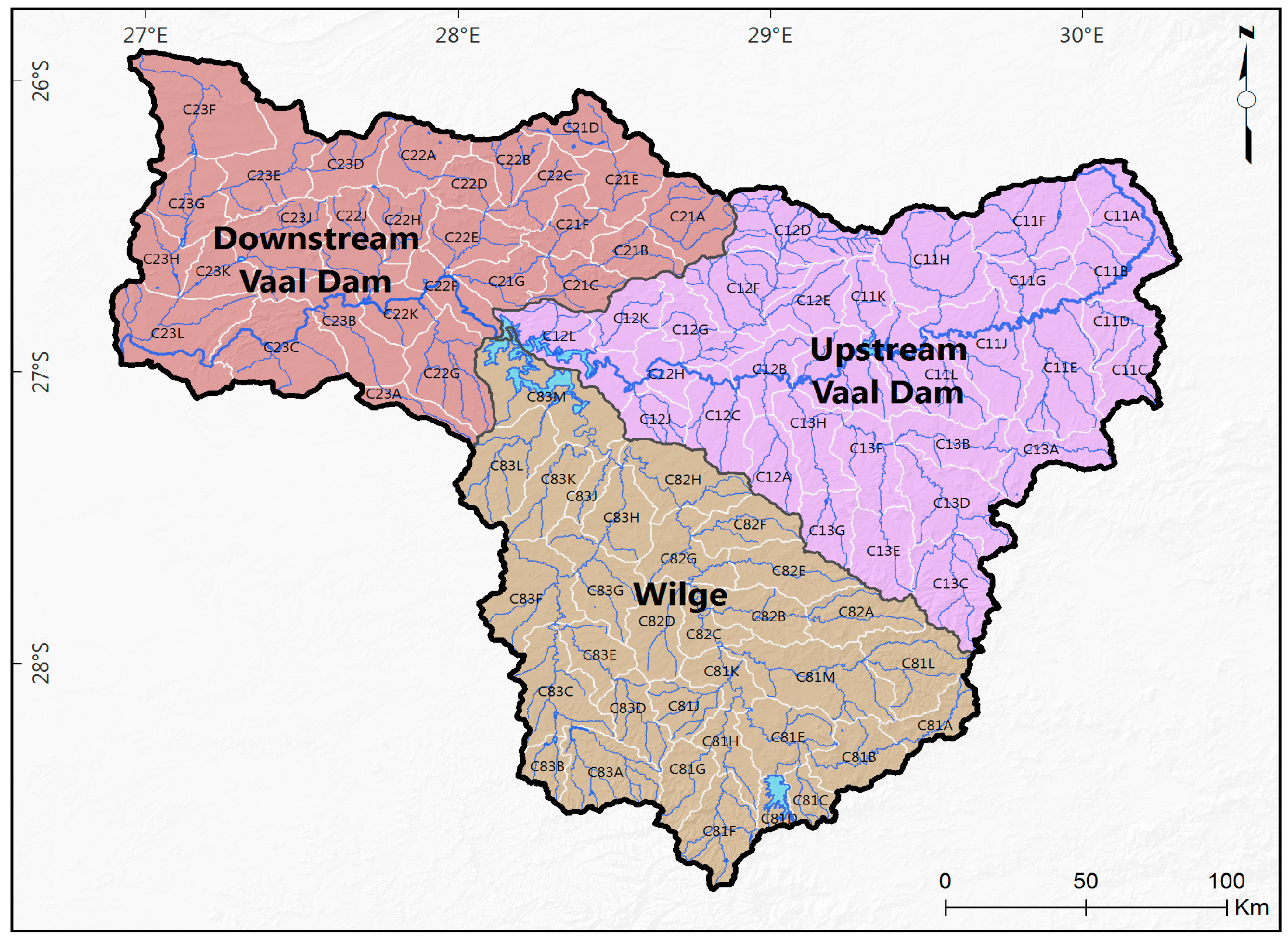

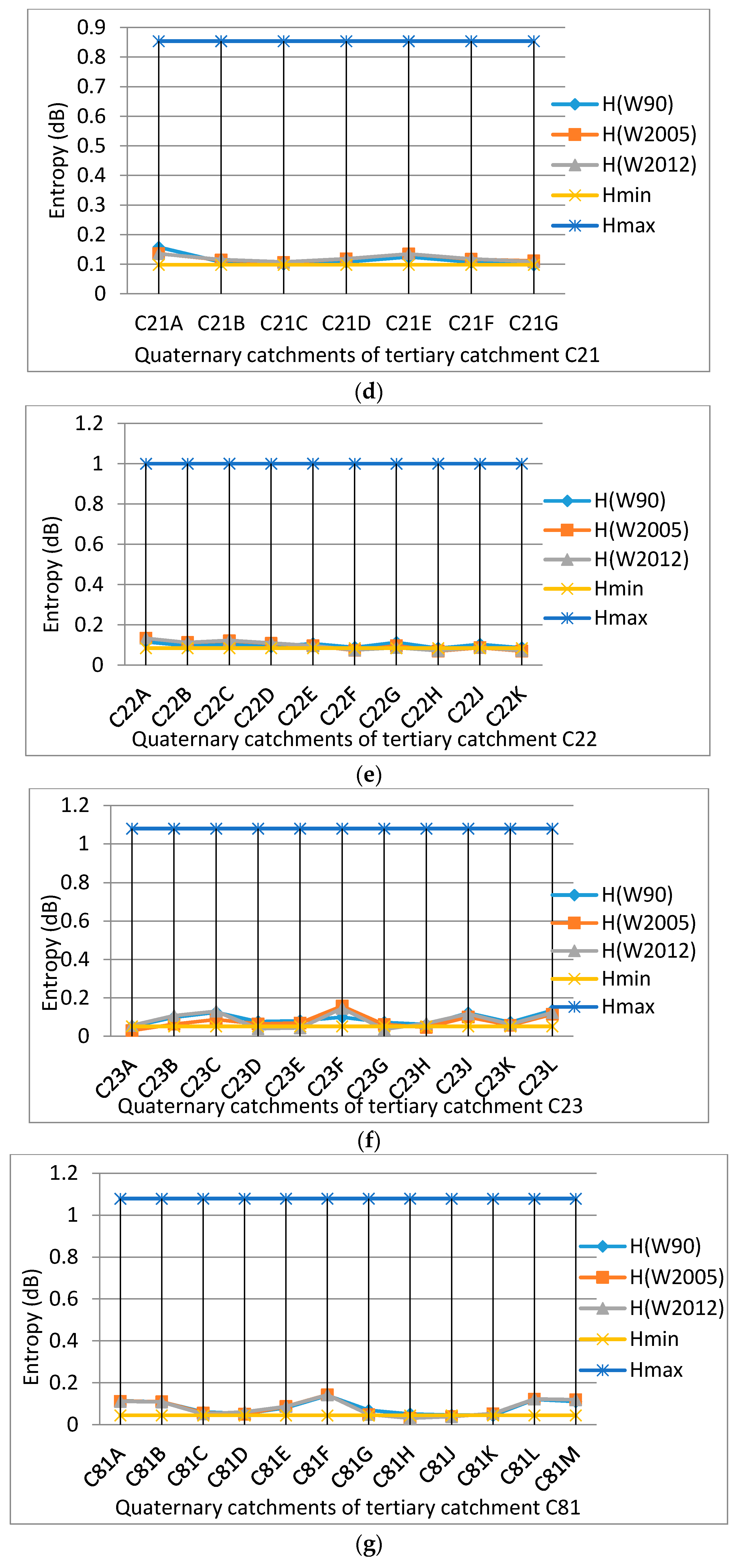
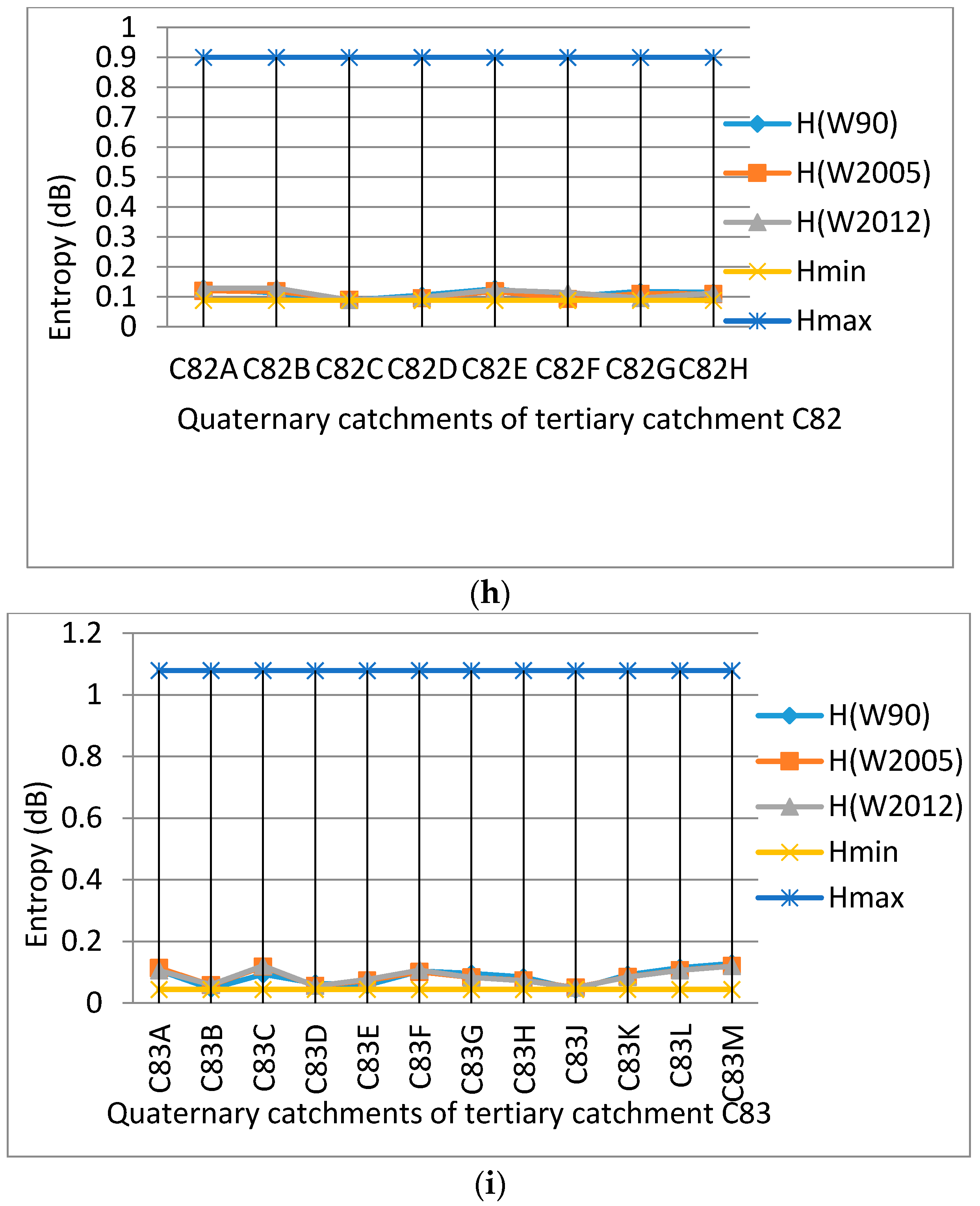
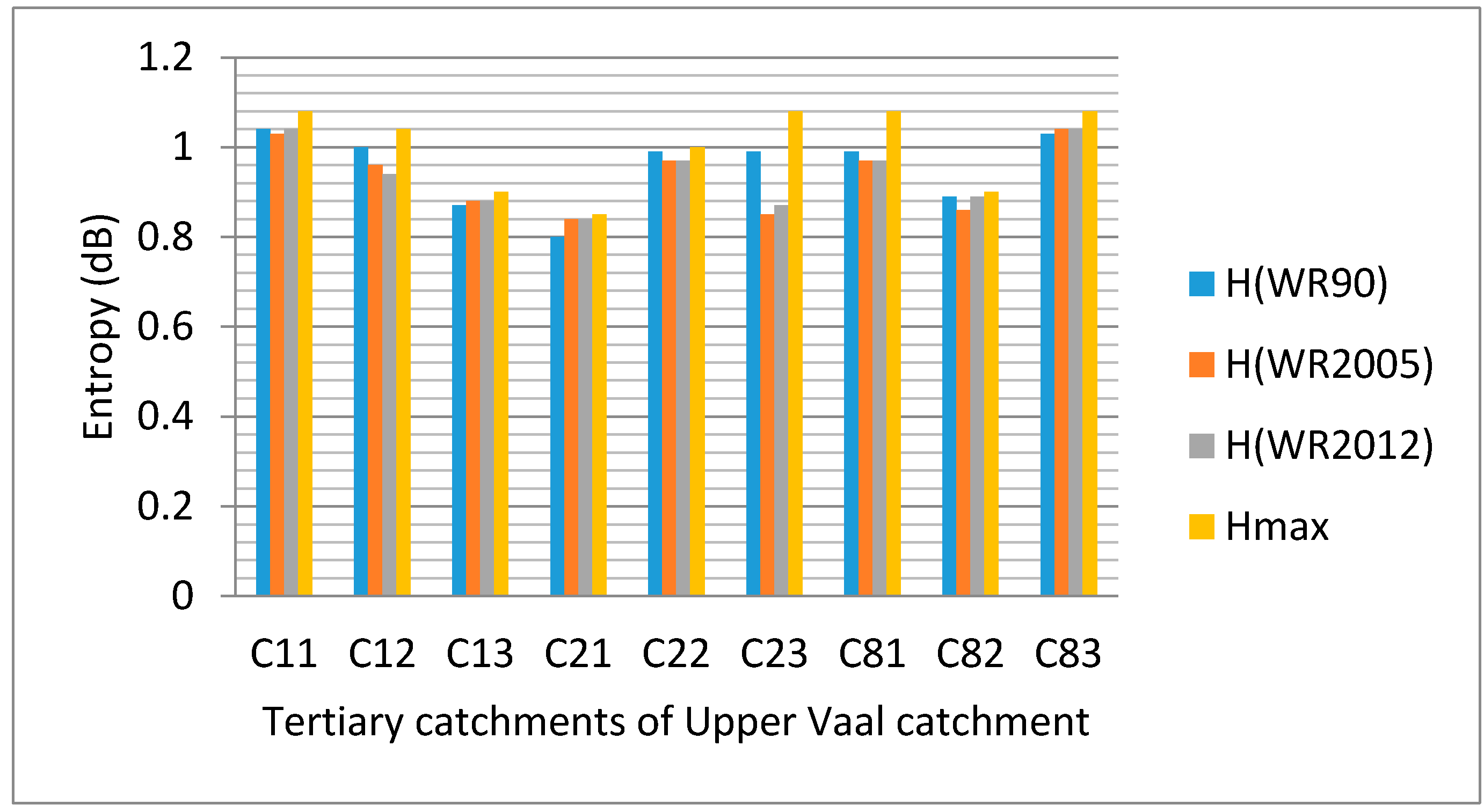
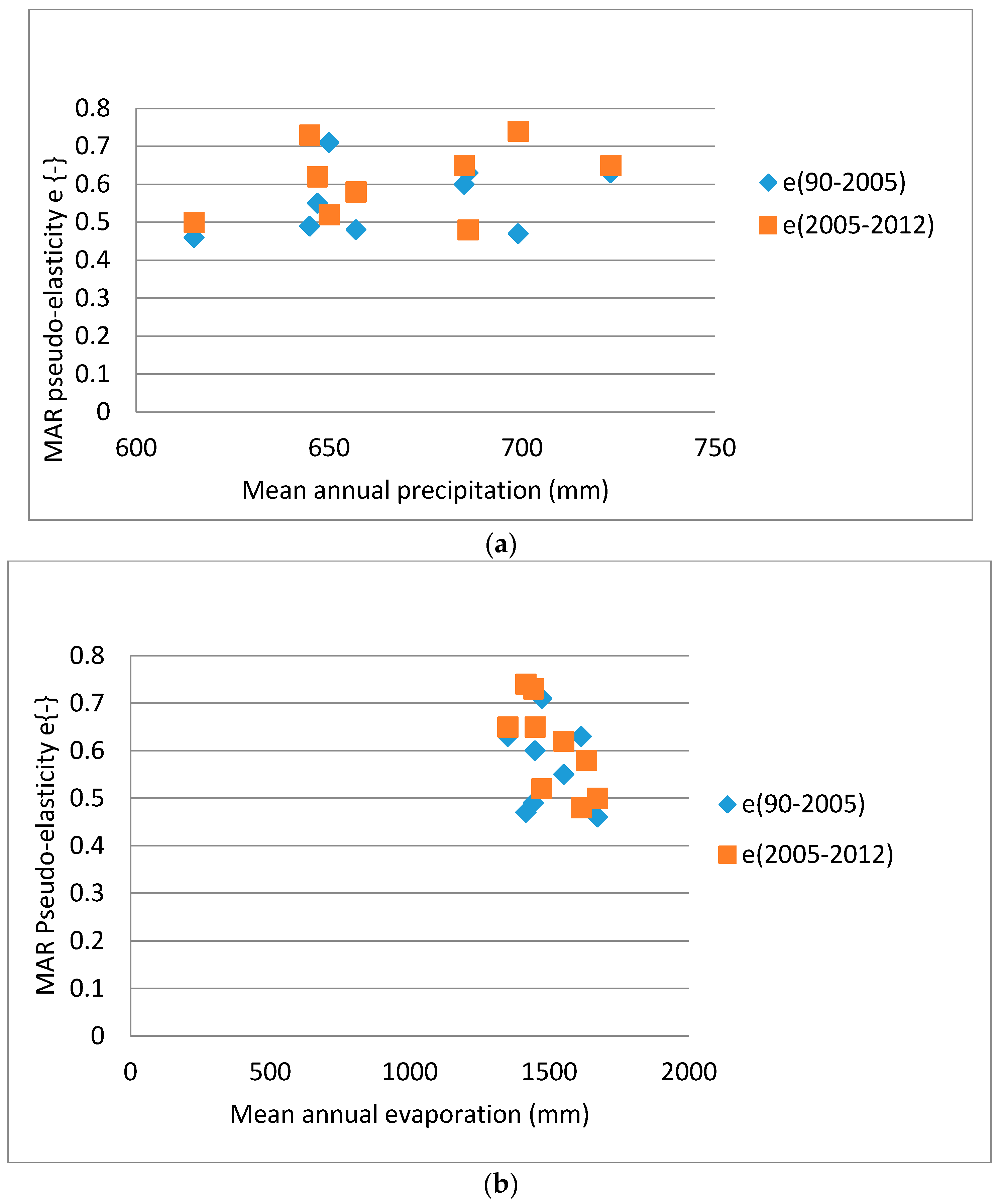
| Tertiary Catchment (TC) | Area (km2) | MAP (mm) | MAE (mm) | MAR (WR90) MCM | MAR (WR2005) MCM | MAR (WR2012) MCM | Number of QC in TC |
|---|---|---|---|---|---|---|---|
| C11 | 8791 | 685 | 1449 | 548.2 | 546.28 | 527.34 | 12 |
| C12 | 6498 | 647 | 1552 | 296.7 | 231.32 | 211.96 | 11 |
| C13 | 5182 | 699 | 1416 | 291.8 | 322.49 | 343.05 | 8 |
| C21 | 3541 | 686 | 1614 | 141.5 | 89.88 | 98.98 | 7 |
| C22 | 5110 | 657 | 1633 | 131.5 | 150.02 | 157.51 | 10 |
| C23 | 8273 | 615 | 1673 | 238.7 | 185.68 | 219.00 | 11 |
| C81 | 6167 | 723 | 1351 | 450.6 | 515.02 | 529.08 | 12 |
| C82 | 4471 | 645 | 1443 | 198 | 214.82 | 151.72 | 8 |
| C83 | 7529 | 650 | 1478 | 283.8 | 236.76 | 252.56 | 12 |
| Tertiary Catchment | Relative Change in H (WR2005/WR90) | Relative Change in H (WR2012/WR2005) |
|---|---|---|
| C11 | −1.13 | 0.97 |
| C12 | −3.78 | −1.04 |
| C13 | 0.30 | 0 |
| C21 | 4.45 | 0 |
| C22 | −2.39 | 0 |
| C23 | −14.35 | −2.35 |
| C81 | −2.50 | 0 |
| C82 | 4.40 | 3.5 |
| C83 | 0.68 | 0 |
| Tertiary Catchment | Linear Model (WR2005/WR90) | Linear Model (WR2012/WR2005) |
|---|---|---|
| C11 | (R2 = 98.36%, = 0.65 ) | (R2 = 99.12%, = 0.65) |
| C12 | (R2 = 91.8%, = 0.55) | (R2 = 98.2%, = 0.62) |
| C13 | (R2 = 99.00%, = 0.47 ) | (R2 = 98.40%, = 0.74 ) |
| C21 | (R2 = 99.10%, = 0.63) | (R2 = 99.1%, = 0.48) |
| C22 | (R2 = 98.36%, = 0.48) | (R2 = 99.8%, = 0.58) |
| C23 | (R2 = 95.40%, = 0.46) | (R2 = 96.9%, = 0.5) |
| C81 | (R2 = 99.0%, = 0.63) | (R2 = 99.88%, = 0.65) |
| C82 | (R2 = 98.85%, = 0.49) | (R2 = 99.57%, = 0.74) |
| C83 | (R2 = 98.00%, = 0.71 ) | (R2 = 99.41%, = 0.52) |
© 2017 by the author. Licensee MDPI, Basel, Switzerland. This article is an open access article distributed under the terms and conditions of the Creative Commons Attribution (CC BY) license (http://creativecommons.org/licenses/by/4.0/).
Share and Cite
Ilunga, M. Assessing Catchment Resilience Using Entropy Associated with Mean Annual Runoff for the Upper Vaal Catchment in South Africa. Entropy 2017, 19, 147. https://doi.org/10.3390/e19050147
Ilunga M. Assessing Catchment Resilience Using Entropy Associated with Mean Annual Runoff for the Upper Vaal Catchment in South Africa. Entropy. 2017; 19(5):147. https://doi.org/10.3390/e19050147
Chicago/Turabian StyleIlunga, Masengo. 2017. "Assessing Catchment Resilience Using Entropy Associated with Mean Annual Runoff for the Upper Vaal Catchment in South Africa" Entropy 19, no. 5: 147. https://doi.org/10.3390/e19050147






